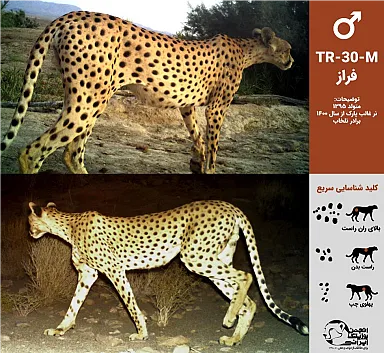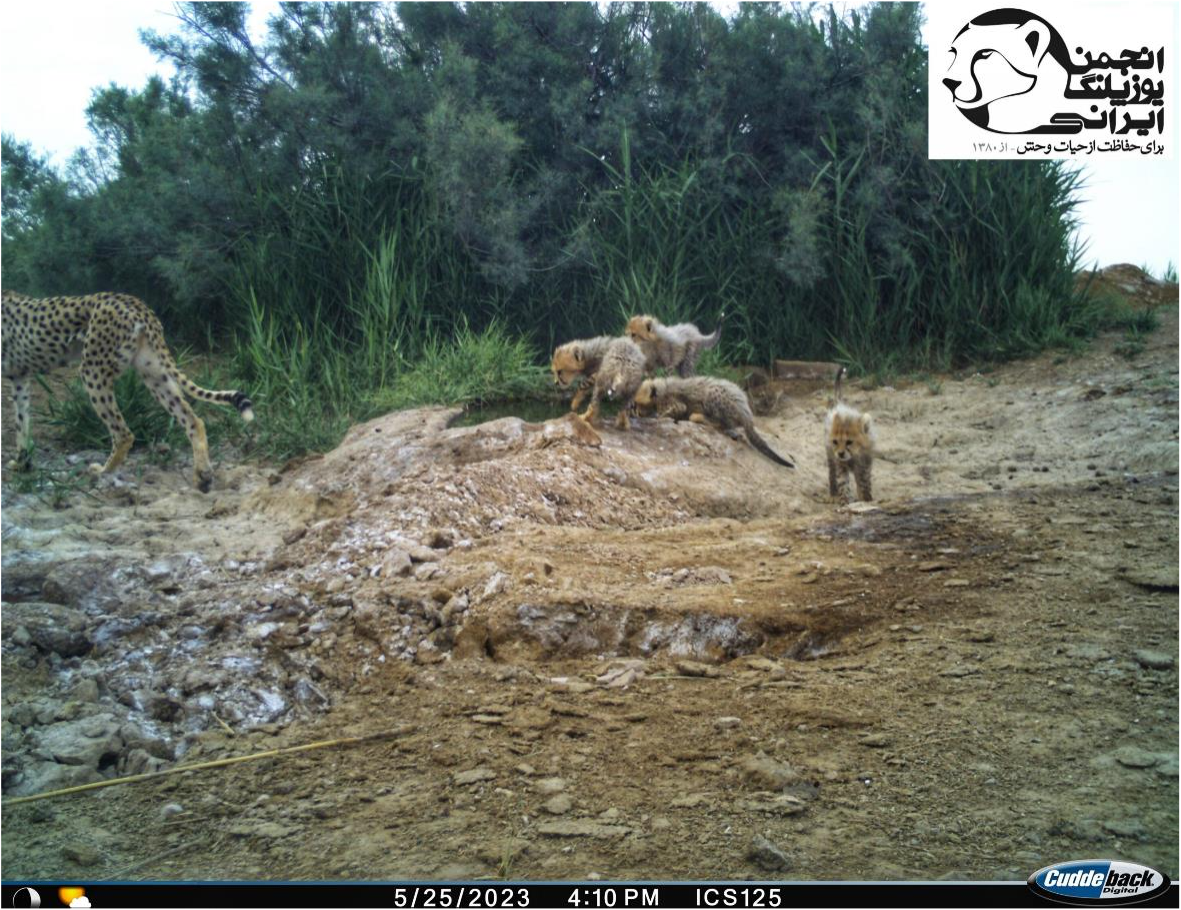
The Asiatic Cheetah:
A Subspecies on the Brink of Extinction
The Asiatic Cheetah: A Subspecies on the Brink of Extinction
- Author: Kristine Piedad
- Publication Date: September 15, 2023
- Focus Species: Acinonyx jubatus (Cheetah)
The Asiatic cheetah once roamed from Saudi Arabia to India, but today its range is limited to a small area in Iran. A cousin to the better known African cheetah, the Asiatic cheetah (Acinonyx jubatus venaticus) is an important part of its native ecosystems, occupying hilly, mountainous terrain in eastern Iran. It is a critically endangered subspecies of cheetah with less than 40 individuals remaining worldwide.
The modern range of the Asiatic cheetah has decreased in the last several centuries due to numerous anthropogenic, or human-caused, reasons, such as hunting and changes to the natural landscape. Cheetahs require a lot of space, with the Iranian Asiatic cheetahs observed to cover over 200 kilometers within the span of a few months. The remaining cheetahs in Iran have been threatened due to their habitat being split up by roads, forcing cheetahs to cross these roads in order to access their remaining habitat. One to two Asiatic cheetahs are killed every year by cars; in such a small population, every loss is a devastating blow. In the years between 2005 and 2011, more than 40% of the cheetahs killed in Iran were killed by cars. The cheetah is also greatly threatened by being forced to share land with livestock; increased human interaction has increased the chances for poaching, being killed by livestock guardian dogs, and competition with livestock for limited food and water resources.
Today, the Asiatic cheetah’s population is likely limited to only the Touran Biosphere Reserve in northeastern Iran. It has not been sighted in other reserves for several years. The reserve is an area of over 1,464,992 hectares, or over 5600 miles.
The Iranian Cheetah Society (ICS) is the primary organization working towards their conservation, in cooperation with Iran’s Department of the Environment. The ICS has faced many difficulties during their twenty plus years of work towards cheetah conservation. Sanctions against Iran have made finding funding for their work difficult. Without funding, much of the work for the ICS must be done on a voluntary basis, limiting available labor and making projects very difficult. Despite the barrier of limited labor and funding, the ICS has worked hard for the conservation of the Iranian cheetah. The ICS, with help from the Netherlands’ IUCN National Committee, worked for several years to secure 5,600 hectares, or over 21 square miles, within the Touran Biosphere Reserve. This area is now clear of livestock use, making it a haven for the Asiatic cheetah. The ICS has also worked to provide water for the cheetahs, enlisted locals to aid in conservation efforts, and recruited and equipped new rangers in order to increase the area patrolled. In 2020, the Department of Roads and Urban Development proposed a new road that would have cut across cheetah habitat in a major protected corridor, potentially increasing the amount of cheetahs killed by cars; the ICS, working with the Department of the Environment, stopped the construction of the road.
The very small size of the remaining cheetah population in Iran is a serious threat to the survival of the species, even if all outside dangers were removed. Cheetahs are already notable for having likely undergone a genetic bottleneck thousands of years ago, with the population becoming so small that genetic diversity became very limited. The current Asiatic cheetah population of less than 40 will be an even smaller bottleneck, and will require significant human intervention if the subspecies is to be preserved. The ICS is committed to working to conserve the cheetah within its natural habitat, as well as to using captive breeding methods. The ICS has been cooperating with Ashia’s Cheetah Center, in South Africa, to share knowledge regarding captive breeding for cheetahs.
Despite the difficulties they have faced, the Iranian Cheetah Society remains optimistic and dedicated to the goal of preserving the Asiatic cheetah and the habitats they call home. There is still hope for the future; just last May, a new family with four cubs was spotted in Touran National Park. The work done by the ICS has helped protect the cheetahs, but in order for the Asiatic cheetah to survive, the Iranian Cheetah Society will need increased funding and support for the cause in the future.
 Asiatic cheetahs on camera traps (Iranian Cheetah Society)
Asiatic cheetahs on camera traps (Iranian Cheetah Society)
The three main habitats of Asiatic cheetahs in Iran. They are now extinct from the western habitat (Map from Iranian Cheetah Society).

Follow the Iranian Cheetah Society on Youtube, Facebook, Instagram, LinkedIn, and Twitter.
References
Hoogeslag, M. 2023. Protecting the Asiatic cheetah in Iran: Meet Morteza Pourmirzai. IUCN: National Committee of the Netherlands. https://www.iucn.nl/en/story/protecting-the-asiatic-cheetah-in-iran-meet-morteza-pourmirzai/
Iranian Cheetah Society. (2013, January 14). More than 40% of cheetahs killed on roads in Iran. https://www.wildlife.ir/en/2013/01/14/more-than-40-of-cheetahs-killed-on-roads-in-iran/
Iranian Cheetah Society. (2014, June 19). Water for Cheetahs. https://www.wildlife.ir/en/2014/06/19/water-cheetahs/
Iranian Cheetah Society. (n.d.). Asiatic Cheetah: Racing Against Extinction. https://www.wildlife.ir/en/asiatic-cheetah/
Menotti-Raymond, M., & O'Brien, S. J. (1993). Dating the genetic bottleneck of the African cheetah. Proceedings of the National Academy of Sciences of the United States of America, 90: 3172.
Pourmir. (2020, September 26). New threat for the asiatic cheetah habitat. https://www.wildlife.ir/en/2020/09/26/new-threat-for-the-asiatic-cheetah-habitat/
Pourmir. (2021, February 20). End of annual “Asiatic Cheetah Population Monitoring Program.” https://www.wildlife.ir/en/2021/02/20/2020-asiatic-cheetah-population-monitoring-program/
Pourmir. (2021, March 17). Livestock removed from a 5,600+ hectares area to make it a secure home for Asiatic Cheetah. https://www.wildlife.ir/en/2021/03/17/livestock-removed-from-a-5600-hectares-area-to-make-it-a-secure-home-for-asiatic-cheetah/
Pourmir. (2021, August 22). Proof of Asiatic Cheetah presence in rangeland which ICS and IUCN NL secured for Conservation. https://www.wildlife.ir/en/2021/08/22/proof-of-asiatic-cheetah-presence-in-rangeland-which-ics-and-iucn-nl-secured-for-conservation/
Pourmir. (2021, September 27). 2019-2020 Biannual Report. https://www.wildlife.ir/en/2021/09/27/2019-2020-biannual-report/
Pourmir. (2023, July 12). Asiatic Cheetah Conservation: A Success Story. https://www.wildlife.ir/en/2023/07/12/asiatic-cheetah-conservation-a-success-story/
UNESCO World Heritage Convention. (2023). Touran Biosphere Reserve. https://whc.unesco.org/en/tentativelists/5275/
Zoos-Media. (2020, November 22). Asiatic Cheetahs in Danger. http://zoos.media/media-echo/asiatic-cheetahs-in-danger/?lang=en
Do You Have 2-4 Hours A Month To Preserve Your Local Ecosystem?
Our volunteers are the driving force behind making true change in ecosystem health and wild cat conservation. Some like to volunteer in the field, others help us maintain our online presence, and some work with events. With just a few hours a month, you can make a difference, too.
Make A Difference Right Now
As a 501(c)3 nonprofit, our work is only possible because of generous donors like you.
More than 90% of your donation will go directly to our groundbreaking research, outreach, and education programs.
This is where true change starts. If you’d like to be a part of it, make a donation to Felidae Conservation Fund today:
Or,
